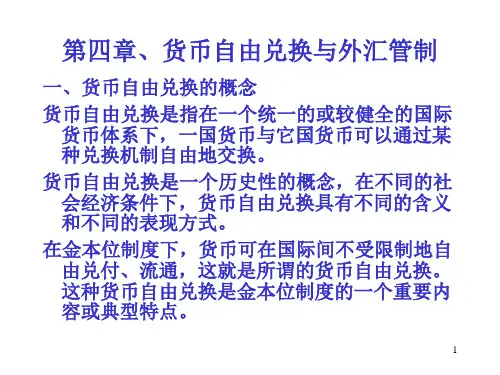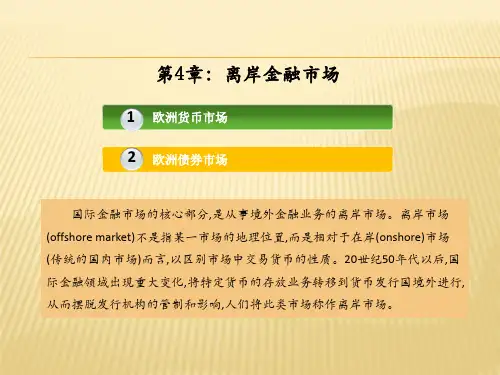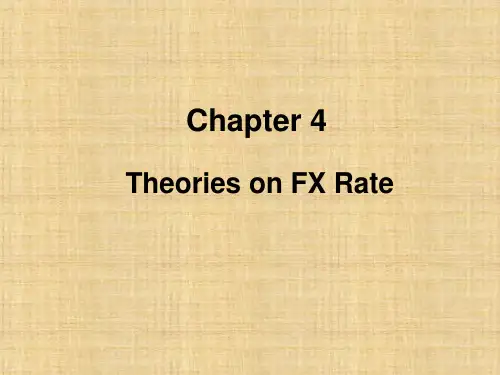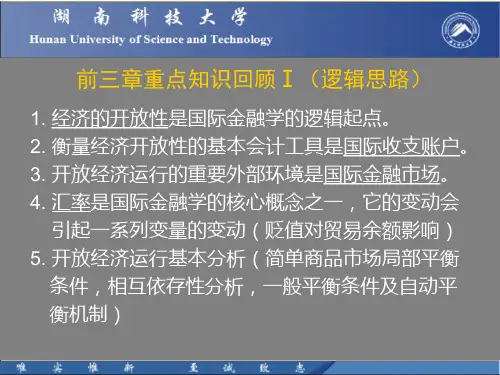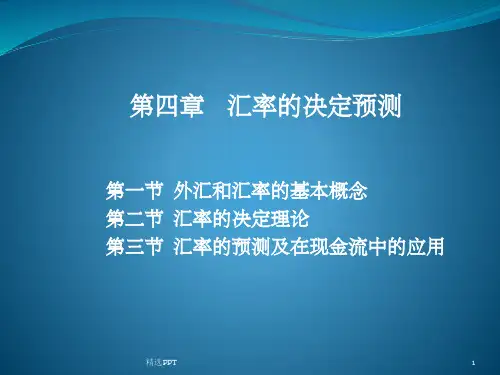- 1、下载文档前请自行甄别文档内容的完整性,平台不提供额外的编辑、内容补充、找答案等附加服务。
- 2、"仅部分预览"的文档,不可在线预览部分如存在完整性等问题,可反馈申请退款(可完整预览的文档不适用该条件!)。
- 3、如文档侵犯您的权益,请联系客服反馈,我们会尽快为您处理(人工客服工作时间:9:00-18:30)。
McGraw-Hill/Irwin
© 2004 The McGraw-Hill Companies, Inc., All Rights Reserved.
18-15
D.Exchange rates in the short run
• 2. The role of the Expected future spot exchange rate: • Assuming that the interest rate differential is unchanged,the increase in the expected future spot rate alters the return diffetential in favor of foreign currency-denominated bonds. • The increase in demand for foreign currency increases the current spot exchange rate.
exchange rates eventually follow PPP, then they lead to stabilizing speculation—speculation that tend to move the exchange rate toward a value consistent with the economic fundamentals of national price levels.
McGraw-Hill/Irwin
© 2004 The McGraw-Hill Companies, Inc., All Rights Reserved.
18-3
Chapter4 Objectives
• 4. looks at how useful these concepts and relationships really are.
ห้องสมุดไป่ตู้
McGraw-Hill/Irwin
© 2004 The McGraw-Hill Companies, Inc., All Rights Reserved.
18-9
C. A ROAD MAP
• The third step: • monetary approach to exchange rates emphasizes the importance of money supplies and demands as key to understanding the determinants of exchange rates.
18-5
Figure 4.1, Panel B
McGraw-Hill/Irwin
© 2004 The McGraw-Hill Companies, Inc., All Rights Reserved.
18-6
A.three types of variability
• First, there are long-term trends in which some
McGraw-Hill/Irwin
© 2004 The McGraw-Hill Companies, Inc., All Rights Reserved.
18-13
D.Exchange rates in the short run
• (2).If the domestic interest rate decreases, with foreign interest rate and the expected future spot exchange rate unchanged,the current spot exchange rate increases.
McGraw-Hill/Irwin
© 2004 The McGraw-Hill Companies, Inc., All Rights Reserved.
18-18
D.Exchange rates in the short run • (2). if expectations are based on a belief that
McGraw-Hill/Irwin
© 2004 The McGraw-Hill Companies, Inc., All Rights Reserved.
18-11
D.Exchange rates in the short run
• Uncovered interest parity links together four variables:the domestic interest rate,the foreign interest rate,the current spot exchange rate and the expected future spot exchange rate.
McGraw-Hill/Irwin
© 2004 The McGraw-Hill Companies, Inc., All Rights Reserved.
18-14
D.Exchange rates in the short run
• (3). If the foreign interest rate decreases,the current spot exchange rate decreases. • (4).If the interest rate differential increases(i-if),the return differential shifts in favor of domestic currency bonds,and current spot exchange rate decrease.
McGraw-Hill/Irwin
© 2004 The McGraw-Hill Companies, Inc., All Rights Reserved.
18-4
Figure 4.1, Panel A
McGraw-Hill/Irwin
© 2004 The McGraw-Hill Companies, Inc., All Rights Reserved.
McGraw-Hill/Irwin
© 2004 The McGraw-Hill Companies, Inc., All Rights Reserved.
18-10
C. A ROAD MAP
• The fourth part: • We examing the tendency for exchange rates to “overshoot”,to change more than seems necessary in reaction to changes in government policies or to other important economic or political news.
McGraw-Hill/Irwin
© 2004 The McGraw-Hill Companies, Inc., All Rights Reserved.
18-16
D.Exchange rates in the short run
• If the expected future spot exchange rate decreases,with the interest rate differential unchanged,the return differential changes in favor of domestic-currency investments, the current spot exchange rate value of the foreign currency decreases.
currencies tend to appreciate against the dollar, and other tend to depreciate. • Second, there are medium-term trends which are sometimes counter to the longer trends. • Third, there is a substantial variability during the short run.
McGraw-Hill/Irwin
© 2004 The McGraw-Hill Companies, Inc., All Rights Reserved.
18-12
D.Exchange rates in the short run • 1.The role of interest rates:
• (1).If the domestic interest rate increases, with foreign interest rate and the expected future spot exchange rate unchanged,the current spot exchange rate decreases.
CHAPTER 4 What Determines Exchange Rates?
McGraw-Hill/Irwin © 2004 The McGraw-Hill Companies, Inc., All Rights Reserved.
18-2
Chapter4 Objectives
• The chapter presents • 1.what we know about exchange movements during these time periods of different lengths • 2. focus on the determinants of exchange rates.(the asset market approach and purchasing power parity ) • 3.examine the role of money as a determinant of national product price levels and inflation rates.

